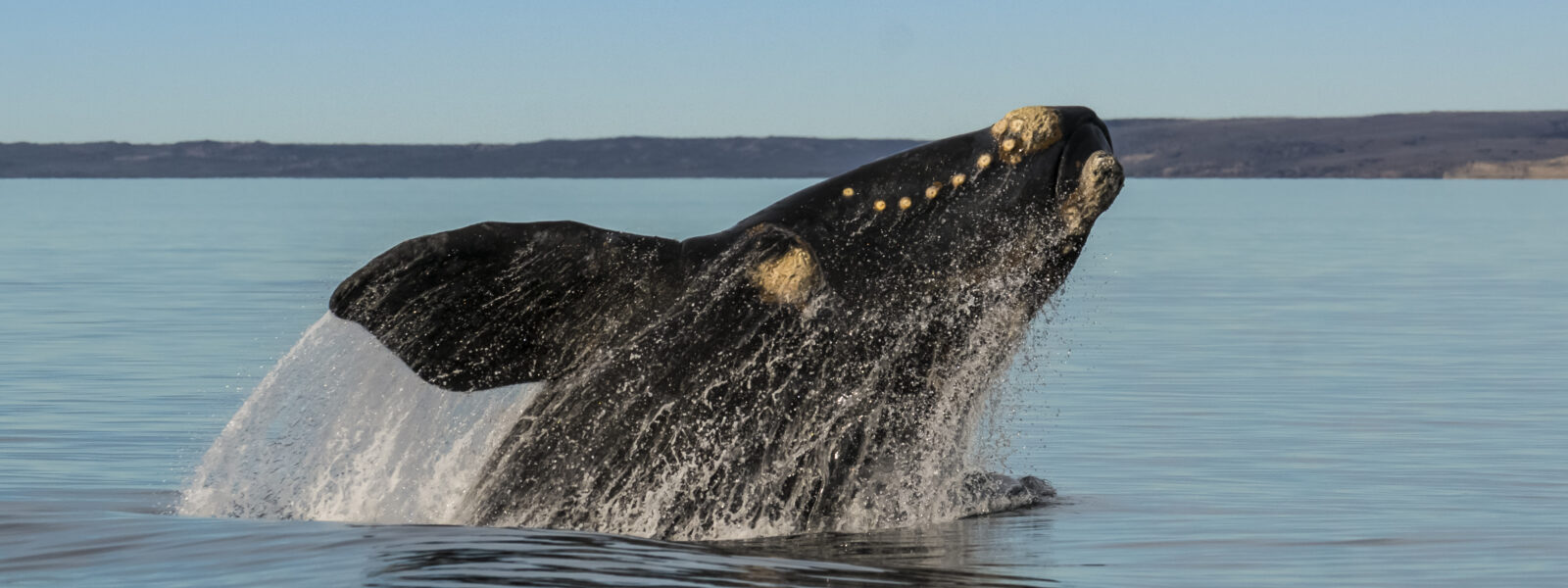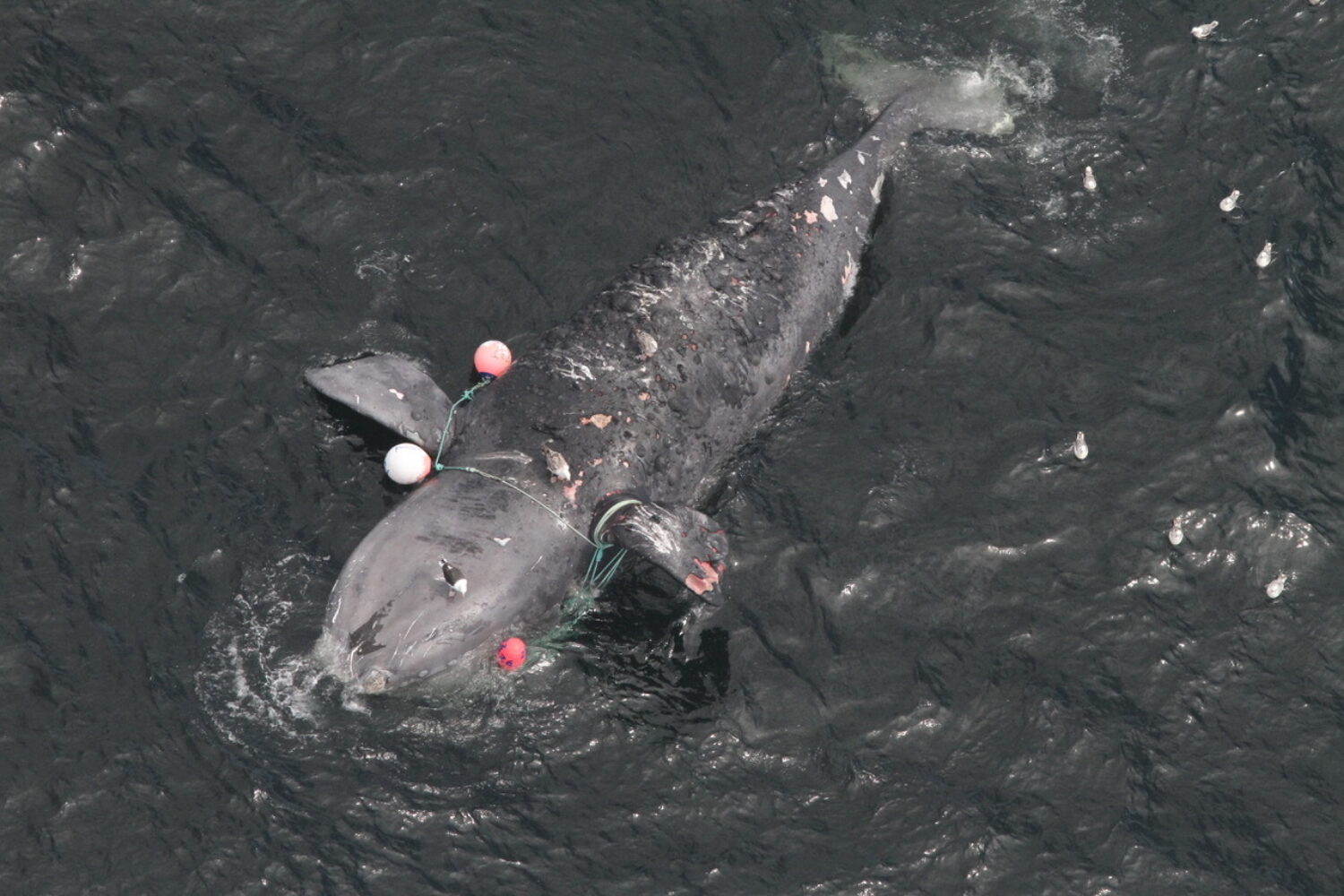
Support Slowing Down Ships to Protect Atlantic Right Whales
By Rosemary Ellis
In February 2021, a group of seven went out on a boat to go fishing in St. Augustine, Florida. Around 6:20 pm, as they were heading back to land, they heard a loud thud. Their boat lost all engine power and as the boat was sinking, they were rescued. Fortunately, no (human) injuries were reported. What they had hit that day tragically did not have the same fate…
A dead two-month-old Atlantic right whale calf washed ashore days later at a nearby beach. The calf was covered in wounds consistent with boat propeller strikes, and his skull and rib bones were fractured.
The 54-foot boat was traveling at 21 knots (nautical miles per hour) when the calf was struck. Fast enough to kill him.
The International Marine Mammal Project (IMMP) of Earth Island Institute recently signed onto comments prepared by the Southern Environmental Law Center about proposed restrictions on vessel speeds in the Atlantic right whale’s waters. IMMP featured the plight of the right whale in our recent report: The Plastics Plague: Marine Mammals and Our Oceans in Peril. Read the report.
Sadly, the Atlantic right whale is the world’s most endangered large whale species, and estimates suggest there are merely 340 remaining along the US Atlantic coast. Commercial whalers hunted Atlantic right whales to very low numbers, and their population never recovered. It’s believed they got their name from whaling in that they were the “right” whales to hunt since they floated to the surface when killed. While whaling is no longer a threat in the waters they frequent, entanglements in fishing gear and vessel strikes are two very serious dangers that are causing the population to dwindle.
Atlantic right whales live in the waters along the East Coast of the US, which unfortunately overlaps with some of the world’s most heavily trafficked waters, with extensive commercial and recreational vessel traffic. Atlantic right whales migrate seasonally, spending their spring, summer, and some of fall in the waters off of New England and Canada, where they feed and mate. In the fall, some migrate to their calving grounds off of South Carolina, Georgia, and Florida. The Mid-Atlantic region has become widely considered to be a seasonally important foraging area, as many right whales migrate between the foraging and calving grounds, and there is evidence that the whales are spending more time there year-round.

In addition to ship strikes, right whales often get entangled in fishing gear, especially plastic lines connecting surface buoys to crab and lobster traps deployed along the Atlantic Coast. IMMP supports the use of ropeless gear to prevent entanglements. Photo Credit: Peter Daley Northeast Fisheries Science Center NOAA collected under MMPA 17355
Right whales travel at relatively slow speeds and spend extended time at or near the surface of the water, which makes them even more prone to vessel strikes than some other whales. Since 2017, vessels have killed an average of three right whales per year, and mothers and calves are disproportionately vulnerable to these vessel strikes. Studies have demonstrated that simply slowing the vessel speeds in right whale habitat significantly reduces the risk of serious injury and mortality from vessel collisions.
In 2008, National Marine Fisheries Service (NMFS) implemented vessel speed restrictions along the U.S. East Coast, called “the 2008 Vessel Speed Rule”, with the goal to: “reduce the occurrence and severity of vessel collisions with North Atlantic right whales.” The Rule established a mandatory 10-knot speed limit for large vessels (more than 65 ft in length), within Seasonal Management Areas (SMA). Additionally, they created a voluntary Dynamic Management Area (DMA), in which three or more right whales were sighted in an area not covered under an active SMA. Boaters are asked to avoid those areas or only travel at speeds less than 10 knots through them for a 15-day period after right whales are spotted.
Was this Rule effective? A 2021 report concluded that it was. The number of right whale mortalities from vessel strikes decreased after the Rule went into effect, and there was a steady increase in compliance with the speed reduction measure over time.
However, there are critical improvements that could be made to the Rule, which is now proposed to be upgraded by NMFS, that would increase protections for right whales, all of which IMMP supports:
- Mandating smaller vessels (less than 65 ft) follow the vessel speed rule, as such vessels can still harm and kill right whales when traveling at high speed;
- Expanding the zones in which the Rule applies; and
- Requiring all vessels in which the Rule applies to slow down to 10 knots or less when right whales are spotted nearby, rather than it just being voluntary.
Lastly, we are calling upon the NMFS to finalize and implement strong vessel strike protections as swiftly as possible and to expedite its rulemaking process.
There is no time to waste.
***********************************
